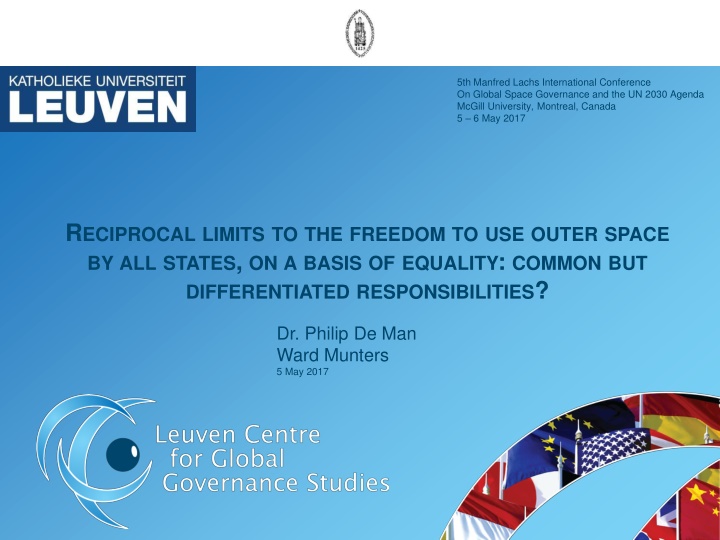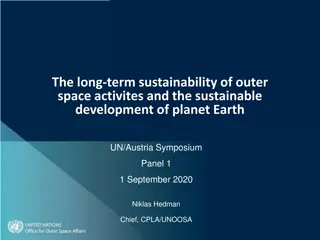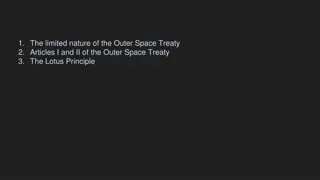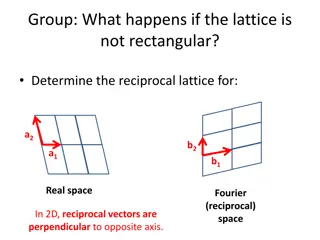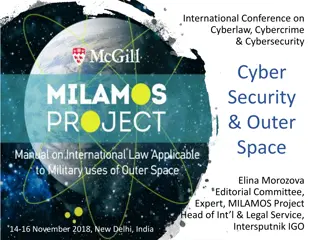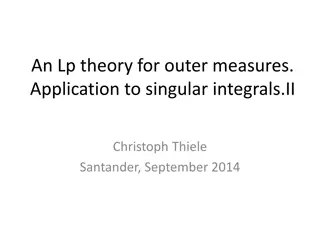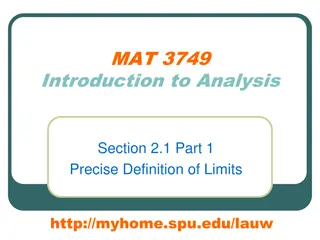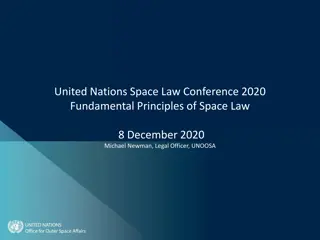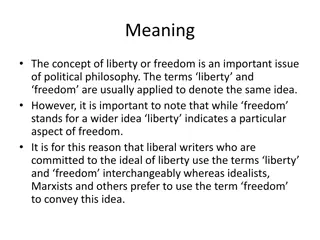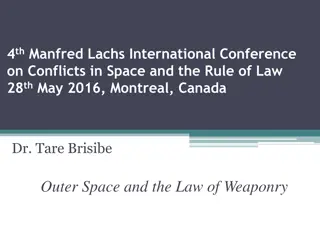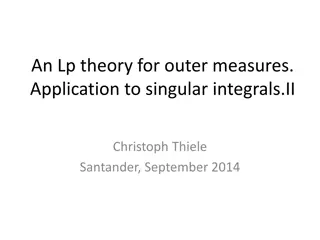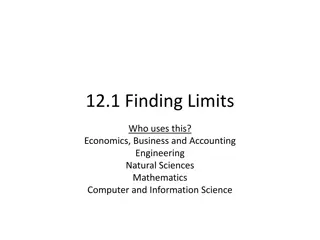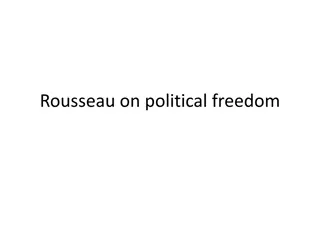Reciprocal Limits to Freedom in Outer Space: Common Responsibilities?
The 5th Manfred Lachs International Conference delves into the topic of differential treatment and common but differentiated responsibilities among sovereign states when it comes to the freedom to use outer space. Exploring the principles of equity and substantive equality, the conference examines the rationale behind differential treatment in international law, emphasizing the need for practical rather than purely formal equality. Through discussions on CBDRs in various international law regimes, including the UNFCCC, the conference aims to highlight the connection between space law and the existing principles of equity and mutual cooperation.
Download Presentation

Please find below an Image/Link to download the presentation.
The content on the website is provided AS IS for your information and personal use only. It may not be sold, licensed, or shared on other websites without obtaining consent from the author.If you encounter any issues during the download, it is possible that the publisher has removed the file from their server.
You are allowed to download the files provided on this website for personal or commercial use, subject to the condition that they are used lawfully. All files are the property of their respective owners.
The content on the website is provided AS IS for your information and personal use only. It may not be sold, licensed, or shared on other websites without obtaining consent from the author.
E N D
Presentation Transcript
5th Manfred Lachs International Conference On Global Space Governance and the UN 2030 Agenda McGill University, Montreal, Canada 5 6 May 2017 RECIPROCAL LIMITS TO THE FREEDOM TO USE OUTER SPACE BY ALL STATES, ON A BASIS OF EQUALITY: COMMON BUT DIFFERENTIATED RESPONSIBILITIES? Dr. Philip De Man Ward Munters 5 May 2017
1. Differential treatment? Sovereign States Equal rights and obligations (cf. Art 2(1) UN Charter) Equity? Uniform and reciprocal rules Formal equality vs. Factual inequality? de iure equality vs. de factoinequality Rationale for differential treatment of States? Legitimacy of international legal order Equity: substantive equality Underlying differential treatment Practical rather than purely formal equality (Cf. UNCTAD, Kyoto Protocol, )
2. Common but Differentiated Responsibilities (CBDRs) Principle 7 of 1992 Rio Declaration on Environment and Development (1992 UNCED) States shall cooperate in a spirit of global partnership to conserve, protect and restore the health and integrity of the Earth s ecosystem. In view of the different contributions to global environmental degradation, States have common but differentiated responsibilities. The developed countries acknowledge the responsibility that they bear in the international pursuit to sustainable development in view of the pressures their societies place on the global environment and of the technologies and financial resources they command Strong link with Sustainable Development and Environmental law Cf. 2030 Agenda for Sustainable Development (UNGA Res 70/1) Cf. New Delhi Declaration of Principles of International Law relating to Sustainable Development, paras. 3.2 & 3.4 (ILA) Differential treatment / CBDRs in variety of International Law regimes Cf. WTO, NPT, ILO Cf. Common Heritage of Mankind UNCLOS, Moon Agreement
3. CBDRs in UNFCCC and beyond? Art. 3.1 UNFCCC The Parties should protect the climate system for the benefit of the present and future generations of humankind, on the basis of equity and in accordance with their common but differentiated responsibilities and respective capabilities. Accordingly the developed country Parties should take the lead in combating climate change and the adverse effects thereof. Kyoto 1997 to Paris 2015 Shift in basis of differentiation (cf. Copenhagen Accord 2009 (CoP 15)) Move away from prescriptive, top-down, formal differentiation Move toward voluntary, self-determined decision-making of States 2015 Paris Agreement Procedural instead of substantive nationally determined contributions References to CBDRs qualified in light of national circumstances Cf. Art. 2.2 PA
4. Space law and CBDRs: existing connections Art. III OST Specific references to needs of developing countries: Remote Sensing Principles, Nuclear Power Source Principles 1996 International Cooperation Declaration States are free to determine all aspects of their participation in international cooperation in the exploration and use of outer space on an equitable and mutually acceptable basis All States, particularly those with relevant space capabilities and with programmes for the exploration and use of outer space, should contribute to promoting and fostering international cooperation on an equitable and mutually acceptable basis. In this context, particular attention should be given to the benefit for and the interests of developing countries and countries with incipient space programmes stemming from such international cooperation conducted with countries with more advanced space capabilities
5. Space law and CBDRs: broader basis Article I, para. 2 OST does not oppose CBDR Discrimination does not equal differentiation CBDR starts from confirmation that all States are equal Article I, para. 1 OST Does not oppose CBDR Special needs of developing countries RMS, 1996 Declaration (interpretative agreement) Requires CBDR Factual differentation on rights side of equation requires distinguishing on obligations side along same axis More flexible distinction based on spacefaring capabilities Article IX OST
6. Space law and CBDRs: guideline for future developments Space debris Mitigation vs. remediation 2011 McGill-Cologne Declaration on Space Debris Recognizing that the principle of common but differentiated responsibility, as enabling all States to fulfil their obligations associated with current international efforts in preserving the terrestrial environment, is an important precedent to guide current and future space debris mitigation and remediation efforts . Resource exploitation Article 11 (7)(d) MA Equity is basis for other regimes ITU (Article 44 (2) ITU CS; see also ITU-D) Deep seabed (Article 148 UNCLOS; Nodules and Sulphides Regulations
7. Conclusions Existing provisions in space law show that CBDR principle in IEL and SD law has evolved to match limited aspirations of 1996 Declaration, adopted at same time as Kyoto Protocol Nevertheless, reciprocal way in which freedoms are granted and delimited in common area of outer space requires legally differentiated responsibilities, for factual inequalities in the exercise of these freedoms means that only then can objectives of space law regime be met
Questions and further info philip.deman@kuleuven.be ward.munters@kuleuven.be
